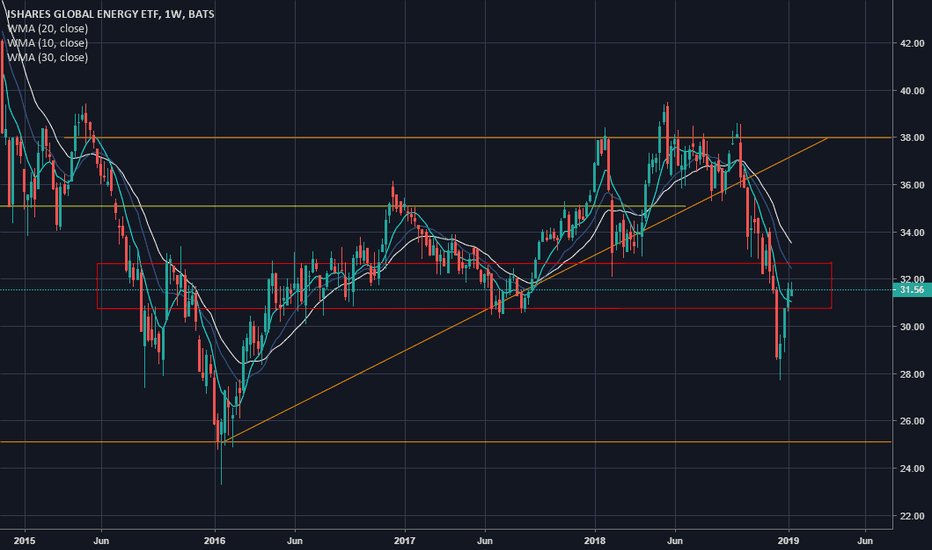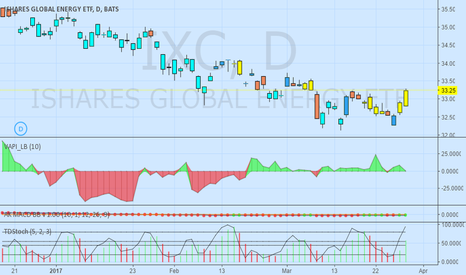iShares Global Energy ETF - $IXC - Major OpportunityiShares Global Energy ETF - AMEX:IXC
This chart and all the others ETF's shared in the below post continue to show major break outs. Its really incredible to see.
✅ Ascending triangle breakout & retest of base
✅ Series of higher lows
✅ Above 200 day SMA
✅ Great Risk Reward set up at 8:1
Garneri
Key stats
About iShares Global Energy ETF
Home page
Inception date
Nov 12, 2001
Structure
Open-Ended Fund
Replication method
Physical
Dividend treatment
Distributes
Distribution tax treatment
Qualified dividends
Income tax type
Capital Gains
Max ST capital gains rate
39.60%
Max LT capital gains rate
20.00%
Primary advisor
BlackRock Fund Advisors
Distributor
BlackRock Investments LLC
IXC fits the bill if youre looking for neutral exposure to the global energy sector. The fund starts off with an underlying index that a committee narrows down to include companies reflective of the broad energy sector. And even though it proportionally weights issuers by market-cap, its large-cap bias introduces a few overweights in the fund, and a heavy investment in a few US giants (but that's inherent to the sector). Overall, it is imperative to note certain concentration risks before investing in this fund. Holdings are market cap-weighted, subject to capping, which limits single security weights to 22.5% and the aggregate of all securities by an issuer exceeding 4.5% to be capped at 45%. The index is rebalanced quarterly in March, June, September, and December. Prior to Mar. 20, 2023, the IXC tracked S&P Global 1200 Energy Index.
Related funds
Classification
What's in the fund
Exposure type
Energy Minerals
Industrial Services
Stock breakdown by region
Top 10 holdings
Energy stocks and ETF will continue to rallyIF you for some reasons are lost and confused finding the right Energy companies to buy, then a global Energy ETF might be suitable. It saves you the hassle of scrutinising the financial performance of the companies and allows you a bigger birds eye view of the global market.
[ENERGY ETF] AWAITING BREAKOUTThis ETF has been falling constantly on the weekly chart as it is waiting for its exhaustion stage to retest the 20 or 30 Day WMA. It could possibly reverse all together and starting its bull trend relative to the volume. For the last week or so it has been trapped and seem to be consolidating. I ha
[TRAPPING THE PRICE] *ENERGY ETF*Finding different weekly support and resistance levels dating back to 2008. I am marking levels that have confirmed the price getting caught in, then when breaking either up or down it will continue that way for a short period of time. Next I will show a daily projection based off of the levels I ha
See all ideas
Summarizing what the indicators are suggesting.
Oscillators
Neutral
SellBuy
Strong sellStrong buy
Strong sellSellNeutralBuyStrong buy
Oscillators
Neutral
SellBuy
Strong sellStrong buy
Strong sellSellNeutralBuyStrong buy
Summary
Neutral
SellBuy
Strong sellStrong buy
Strong sellSellNeutralBuyStrong buy
Summary
Neutral
SellBuy
Strong sellStrong buy
Strong sellSellNeutralBuyStrong buy
Summary
Neutral
SellBuy
Strong sellStrong buy
Strong sellSellNeutralBuyStrong buy
Moving Averages
Neutral
SellBuy
Strong sellStrong buy
Strong sellSellNeutralBuyStrong buy
Moving Averages
Neutral
SellBuy
Strong sellStrong buy
Strong sellSellNeutralBuyStrong buy
Displays a symbol's price movements over previous years to identify recurring trends.
Frequently Asked Questions
An exchange-traded fund (ETF) is a collection of assets (stocks, bonds, commodities, etc.) that track an underlying index and can be bought on an exchange like individual stocks.
IXC trades at 39.70 USD today, its price hasn't changed in the past 24 hours. Track more dynamics on IXC price chart.
IXC net asset value is 39.71 today — it's fallen 1.29% over the past month. NAV represents the total value of the fund's assets less liabilities and serves as a gauge of the fund's performance.
IXC assets under management is 1.78 B USD. AUM is an important metric as it reflects the fund's size and can serve as a gauge of how successful the fund is in attracting investors, which, in its turn, can influence decision-making.
IXC price has fallen by −1.12% over the last month, and its yearly performance shows a −2.89% decrease. See more dynamics on IXC price chart.
NAV returns, another gauge of an ETF dynamics, have fallen by −1.29% over the last month, showed a 8.57% increase in three-month performance and has increased by 1.96% in a year.
NAV returns, another gauge of an ETF dynamics, have fallen by −1.29% over the last month, showed a 8.57% increase in three-month performance and has increased by 1.96% in a year.
IXC fund flows account for −313.10 M USD (1 year). Many traders use this metric to get insight into investors' sentiment and evaluate whether it's time to buy or sell the fund.
Since ETFs work like an individual stock, they can be bought and sold on exchanges (e.g. NASDAQ, NYSE, EURONEXT). As it happens with stocks, you need to select a brokerage to access trading. Explore our list of available brokers to find the one to help execute your strategies. Don't forget to do your research before getting to trading. Explore ETFs metrics in our ETF screener to find a reliable opportunity.
IXC invests in stocks. See more details in our Analysis section.
IXC expense ratio is 0.40%. It's an important metric for helping traders understand the fund's operating costs relative to assets and how expensive it would be to hold the fund.
No, IXC isn't leveraged, meaning it doesn't use borrowings or financial derivatives to magnify the performance of the underlying assets or index it follows.
In some ways, ETFs are safe investments, but in a broader sense, they're not safer than any other asset, so it's crucial to analyze a fund before investing. But if your research gives a vague answer, you can always refer to technical analysis.
Today, IXC technical analysis shows the sell rating and its 1-week rating is buy. Since market conditions are prone to changes, it's worth looking a bit further into the future — according to the 1-month rating IXC shows the buy signal. See more of IXC technicals for a more comprehensive analysis.
Today, IXC technical analysis shows the sell rating and its 1-week rating is buy. Since market conditions are prone to changes, it's worth looking a bit further into the future — according to the 1-month rating IXC shows the buy signal. See more of IXC technicals for a more comprehensive analysis.
Yes, IXC pays dividends to its holders with the dividend yield of 3.88%.
IXC trades at a premium (0.17%).
Premium/discount to NAV expresses the difference between the ETF’s price and its NAV value. A positive percentage indicates a premium, meaning the ETF trades at a higher price than the calculated NAV. Conversely, a negative percentage indicates a discount, suggesting the ETF trades at a lower price than NAV.
Premium/discount to NAV expresses the difference between the ETF’s price and its NAV value. A positive percentage indicates a premium, meaning the ETF trades at a higher price than the calculated NAV. Conversely, a negative percentage indicates a discount, suggesting the ETF trades at a lower price than NAV.
IXC shares are issued by BlackRock, Inc.
IXC follows the S&P Global 1200 Energy 4.5/22.5/45 Capped Index - Benchmark TR Net. ETFs usually track some benchmark seeking to replicate its performance and guide asset selection and objectives.
The fund started trading on Nov 12, 2001.
The fund's management style is passive, meaning it's aiming to replicate the performance of the underlying index by holding assets in the same proportions as the index. The goal is to match the index's returns.




